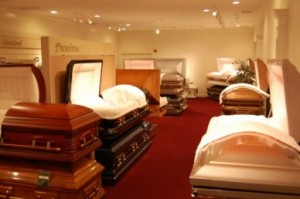This great article was written by Caleb Wilde and posted recently on his personal blog, Confessions of a Funeral Director. He agreed to let me share it with you. I believe it is a solid, unbiased, honest discussion of the funeral industry as it relates to you, the consumer.
Do you think funeral homes charge too much for their merchandise and services?
 I asked this question on my Facebook page yesterday. Over 200 people answered. And the discussion became pretty heated. Being that I like hot topics, I thought I’d take a stab at the question.
I asked this question on my Facebook page yesterday. Over 200 people answered. And the discussion became pretty heated. Being that I like hot topics, I thought I’d take a stab at the question.
Let me preface this article by saying that I am not an economist, nor am I an exceptional business man. The following are ten observations that are a combination of experience in the funeral industry and my heart felt intention to meet the needs of the people I serve – needs that often include an economical funeral.
One. Yes, there are bad guys (and bad corporations) in the funeral industry. Legit racketeers.
Two. Yes, there are good guys.
Funeral directors who are more concerned with helping you through the funeral process than with making money. There’s probably more good guys than bad guys. We’re out there. Find us.
Three. Shifting Cultural Attitude towards Death
The industrialization of dying has removed the dying of our loved ones from home care. The institutionalization of dying means that you will probably die in an institutional setting (hospitals, nursing homes), where “professionals” treat the body while (often) ignoring social and spiritual aspects of dying. In fact, three out of four deaths in the United States occur in a hospital or nursing home, outside of our home surrounding and outside of the comfort of our family.
The professionalization of death has removed death from home and family. The Amish hire the funeral director to embalm the body and produce the legal paper work, but they do the rest. They dress the body, they casket the body, they have the funeral at their home and they direct the funeral service. There’s something to be said about one’s caretakers in life also being one’s caretakers in death.
With the industrialization and professionalization of death and dying, we have had the responsibility taken away from the community, and without that responsibility, without that personal investment in dying and death, we no longer see the full value of funeralization.
Four. Jessica Mitford and the Public Perception.
“You may not be able to change the world, but at least you can embarrass the guilty”, said Mitford. In Stephen Colbert-esque fashion, Mitford’s “The American Way of Death” wittingly embarrassed the abuses of the funeral industry in the 1960s and paved the way for the “Funeral Rule” in the early 1980s.
The “Funeral Rule” is meant “to protect consumers by requiring that they receive adequate information concerning the goods and services they may purchase from a funeral provider.”[1] And while some of the abuses in the funeral industry have been quelled by the Funeral Rule, the depiction of funeral directors as “oleaginous salesman pushing me to buy a mink-lined steel casket with an Eternal Memory Foam pillow fringed in Flemish crepe and gently scented with lilac”[2] has – to one degree or another – remained in the public perception.
On the one hand, it’s important to recognize that Mitford’s criticisms were – and, in some cases, are — warranted; on the other hand, it’s important to recognize that Mitford viewed the funeral industry through the lens of economics and class. She seemed to believe that the funeral industry was based on a desire to assert one’s standing in society. Why else would you spend a couple grand on a funeral, unless you were attempting to distinguish yourself from others? And funeral directors capitalized on this desire to brag in death. In your moment of intense weakness, we play on your pride and reach into your wallet. So, of course we are overcharging … at least, that’s part of the public perception.
Five. Value.
And this leads us to the value of a funeral. In a capitalist market, value is determined by the market … by you. If you value it, you’ll pay for it. And seeing value in a funeral is the real question. It’s not, “Do funeral homes charge too much?”; rather, its, “Is there real value in funerals?” Once we answer the value question, then we can answer the cost question.
If you don’t see value in what a funeral home is offering you, find one that offers you the product and services that you do value.
If you don’t see value in the products that the industry is offering you, demand different products and service.
If we do indeed charge too much, it’s because the market doesn’t see value in what we’re offering.
Six. Trust.
The funeral home that is geographically closest to us charges roughly two grand more per funeral than our funeral home. We know some of the people they bury and – because it’s generally known that our funeral home is rather inexpensive – I often wonder, “Why do they go to Such-and-such Funeral Home when we’re less expensive?” My conclusion? Trust. They have a better relationship with that funeral director than they do with us.
Because we recognize that death has altered our reasoning, when someone dies and we have to make arrangements, we want to go to somebody we trust … and, if possible, someone we already know. In our transient society, there’s situations where we have not connections to funeral directors / funeral homes.
But, when there is trust with a funeral director, when there is a relationship with a funeral director, especially during times of death, money isn’t as much of a consideration. The value of trust usually outweighs the cost.
Seven. Non-profit vs. for profit.
I think there’s an expectation for us to be a non-profit organization. To be a ministry. But, if we were a non-profit ministry, there’d simply be less consumer options. It would be governed by a board, the products would be determined by donors and the service might be even more cookie cutter than it already is.
Eight. Options.
There are options. You should be able to find a funeral home that offers a direct cremation for under $2,000. You don’t have to be embalmed. There are cemeteries that don’t require vaults. There are inexpensive caskets.
You can die at home. You can be more involved in the death process. In 1996 Jessica Mitford was buried for $533.31. With inflation rates factored in, you can purchase the equivalent of Mitford’s funeral today.
Nine. Prepaying / Insurance Policies.
It’s always much more difficult to handle the expenses of a funeral when you have to pay it all at once. Think buying a car with cash. Not all of us can do it.
If you plan ahead, or buy an insurance policy, you can pay in increments and when the time comes it’s not as much of a shock.
Ten. Pre-planning: Now is the Time to Think about Death.
We plan for weddings. We plan for births. Think about your dying and death now. Think about what you want. Think about how you want your funeral to look. Find a funeral director who can meet your needs
[1] http://en.wikipedia.org/wiki/Funeral_Rule
[2] http://www.patheos.com/blogs/godandthemachine/2013/06/finaljourney/
Contact us with questions on a custom cremation wood urn for your beloved family member or precious pet.






